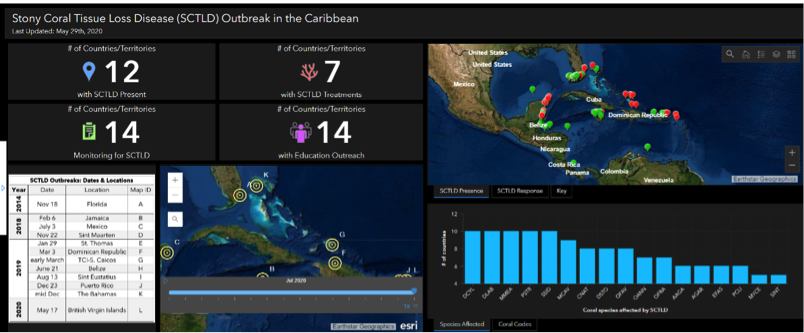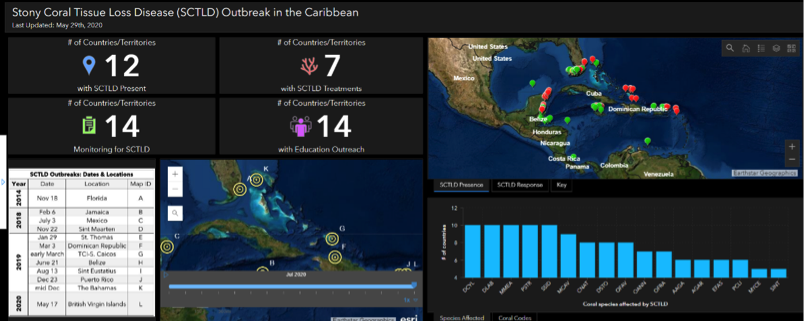MPAConnect and AGRRA Launch Caribbean Coral Disease Dashboard
 June 4, 2020 – As stony coral tissue loss disease spreads in the Caribbean region, a new online tool is tracking its progression and recording the efforts made to control and respond to the threat that it poses to Caribbean coral reefs.
June 4, 2020 – As stony coral tissue loss disease spreads in the Caribbean region, a new online tool is tracking its progression and recording the efforts made to control and respond to the threat that it poses to Caribbean coral reefs.
Stony coral tissue loss disease spreads rapidly and affects some of the slowest-growing and longest-lived reef-building corals, including the iconic brain corals, star corals and pillar corals that provide habitat, shelter and nursery areas for numerous other marine organisms. The loss of these corals affects overall coral reef health and can have cascading impacts on the ecosystem services they provide – like food security, tourism economies, and coastal protection for local communities.
Natural resource managers and their partners across the Caribbean region are actively exchanging information and sharing best practices about coral disease monitoring, treatment and outreach.
“Last year, Caribbean coral reef managers from 17 countries and territories came together in Key West to learn about stony coral tissue loss disease. They suggested the creation of a regional dashboard to share the status of the disease within the Caribbean,” explained Emma Doyle, MPAConnect Coordinator.
“In response to this request, MPAConnect (a partnership between the Gulf and Caribbean Fisheries Institute and NOAA’s Coral Reef Conservation Program) and the Atlantic and Gulf Rapid Reef Assessment Program (AGRRA) collaborated on the development of a GIS-based dashboard as a new online tool for managers.”
Intended to assist with response to stony coral tissue loss disease, the dashboard contains topline statistics that can be viewed at a glance. It contains information from in-water coral reef monitoring that can help managers to shape their response to the disease.
“Maps on the dashboard show the presence of stony coral tissue loss disease around the region, a time lapse of its progression and which coral species have so far been most affected by stony coral tissue loss disease,” commented Patricia Kramer, Program Director of Ocean Research and Education Foundation.
“A new tool is also available that helps to indicate where corals that are most susceptible to SCTLD are located based on existing AGRRA coral reef monitoring data,” she added.
The dashboard is made possible with support from the NOAA Coral Reef Conservation Program and Ocean Research and Education Foundation. It’s hosted by AGRRA using Esri ArcGIS software. To view the dashboard please go to: https://www.agrra.org/coral-disease-outbreak/#sctld-dashboard

Please see here to access a copy of this press release in Spanish and English
For more information please contact [email protected] or [email protected]




Leave a Reply
Want to join the discussion?Feel free to contribute!